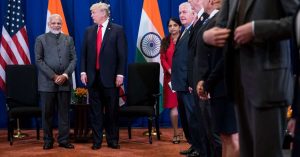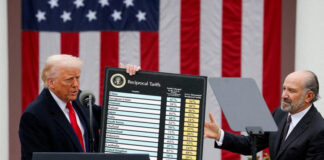MAY 21, 2019
 Indian Prime Minister Narendra Modi of India during a roadshow in Varanasi, India, last month. – Adnan Abidi/Reuters
Indian Prime Minister Narendra Modi of India during a roadshow in Varanasi, India, last month. – Adnan Abidi/Reuters
NEW DELHI — In Hungary, Viktor Orban demonized immigrants and secured an expansion of his power. In Turkey, Recep Tayyip Erdogan purged his enemies and won a new term. In Australia, Scott Morrison shrugged off calls for tougher carbon-emissions rules and was unexpectedly kept on as leader.
And in India, where the world’s biggest parliamentary election appears to be boiling down to a binary choice — Yes or No on Prime Minister Narendra Modi — the electorate seems poised to bring back Mr. Modi, extending the wave of victories by right-wing populists around the world.
India’s election finished on Sunday and the results are scheduled to be announced Thursday. The results may reveal not just a decision on Mr. Modi but a deeper one on what kind of government India really wants.
Does it want a dominating leader who keeps a tight grip on power? Or would it be happier with a messier but more freewheeling coalition government?
And do Indians prefer a religiously driven nation or a secular one? Mr. Modi’s political rise began deep in the ranks of a Hindu nationalist organization, and under him, mob violence has surged against India’s minority Muslims. Many Indians are concerned about the legacy Mr. Modi will leave on India’s social fabric should he remain in power for five more years, the parliamentary term.
 Mr. Modi and President Trump at the ASEAN Summit in Manila, the Philippines, in 2017. – Doug Mills/NY Times
Mr. Modi and President Trump at the ASEAN Summit in Manila, the Philippines, in 2017. – Doug Mills/NY Times
Around the world, it has become the age of the political big man, and no one disputes that Mr. Modi is the biggest force India has produced in decades.
He stirs huge crowds. He sets wildly ambitious goals, such as building 100 million toilets in five years, which he essentially reached (though he failed to deliver on his promise to create millions of new jobs). He projects a strong image of India abroad, putting India in position to play a larger role on the world stage as the United States and China vie for influence around the region. He is decisive and acts more like a president than a prime minister.
At the same time, Mr. Modi, 68, is widely accused of dividing his own people, pitting religious and social communities against each other and cutting out other layers of government in a quest to consolidate power.
 B.J.P. supporters at a public rally in Kolkata last month. – Atul Loke/Getty Images
B.J.P. supporters at a public rally in Kolkata last month. – Atul Loke/Getty Images
Many of Mr. Modi’s supporters see his personalization of power as a good thing. If the exit polls predicting his victory are reliable — and previous exit polls in India have broadly been — it seems that he has followed the same winning recipe of other successful populist and right-leaning politicians like Mr. Orban and Mr. Erdogan.
“Modi is doing what these other leaders are doing — he’s projecting resolve, masculinity, determination, daring and courage,” said Ashutosh Varshney, the director of the Center for Contemporary South Asia at Brown University. “People who are voting for him are voting for a strong national leader.’’
“It’s all coming from the same phenomenon,’’ Mr. Varshney added, “a rise in populism.”
For years, India was run by fractious, weak governments that got tied up in parliamentary dogfights. Big initiatives failed to take off. India struggled to assert itself internationally. In the eyes of his supporters, Mr. Modi is the surest bet for this country to grasp glory and actually get something done.
These days, it’s not unusual to hear Indians describe Modi as “our Trump,” which is said in antipodal ways, either with pride or scorn.
“Trump and Modi are twins separated by continents,” said Chandra Bhan Prasad, a well-known political commentator. “Both are against knowledge, they consider the past as the golden period, they consider themselves the center of gravity.”
Political analysts say there is no shortage of similarities between the two, including their combative style, their prolific use of Twitter and their talent for stoking nationalism — and spreading fear — to firm up their bases.
Mr. Modi’s aspirational message to India’s young and fast-growing population is not so different from Mr. Trump’s “Make America Great Again.”
In Indian politics, there’s no one who can touch Mr. Modi in terms of his forcefulness or his aura. His white bearded face is everywhere and he is a master of the grand gesture. He spent the last moments of the election campaign praying at a Hindu shrine and meditating in a remote Himalayan cave — in front of a film crew. The video of him sitting against a rock wall, eyes closed in apparent bliss, was beamed around India.
His party, the Bharatiya Janata Party, or B.J.P., has built the most organized and richest campaign machine. Some Indian media sites estimate that it has raised more than $700 million, a whopping amount that dwarfs the total of all other parties by several times.
And he enjoys another advantage: His party has a serious ground game. The B.J.P. is closely connected to a network of Hindu religious groups that have sprung into action this election season and sent vast legions of volunteers across India to knock on doors and target voters, down to individual apartment blocs.
Even among Indians who said they voted for the Congress Party, led by Rahul Gandhi, in recent state elections, several said in interviews that when it came down to choosing a national leader, they wanted Mr. Modi.
“The Modi factor seems to be the No. 1 factor in the election,’’ said Josukutty Cheriantharayil Abraham, a political scientist at the University of Kerala.
One reason is how Mr. Modi makes voters feel. He has insisted on a bigger role for India in the world, and it speaks to the desire of many here for a stronger national image.
“Modi is not shy in taking decisions in the national interest,” said Ajit Kumar, a former Indian ambassador.
In February, Mr. Modi nearly went to war with Pakistan, which proved to be a huge boost as the election drew near. The next month, he announced with great fanfare that India now had the capability to shoot down satellites hurtling through space, which only a few countries can do.
Voters across different demographic groups are responding, too.
One of them, Rohita Dwivedi, a marketing professor in Mumbai, talked about how she felt that one of India’s biggest problems was an inferiority complex. Citing Mr. Modi’s vision, and his success in delivering on promises to help the poor and fight corruption, she said, “As an Indian, I am finally proud.”
Politicians are products of their time. In many different societies, globalization is unsettling people, creating a craving for a return to a simpler and more glorious past. Add to that social media, which enables people to filter out what they don’t want to hear. The result, analysts say, is a new generation of strongmen.
Part of the their success lies in an ability to speak to voters directly, bypassing the press or other moderating filters that might spotlight problems.
Mr. Erdogan, for example, makes several big speeches on a daily basis that are carried by friendly broadcasters straight into homes, sidewalk cafes and offices, making them virtually inescapable. President Trump is known for his late-night tweets. At 60 million followers, he is the world’s most followed elected official in office.
Right behind him? Mr. Modi, at 47 million followers.
Democracies are technically built to keep out autocrats. And like the United States, India is equipped with historically independent institutions, such as its Supreme Court and its press.
But Mr. Modi is not India’s first leader to push the boundaries. Jawaharlal Nehru, the first prime minister and Rahul Gandhi’s great-grandfather, developed a cult of personality and ruled virtually unchallenged for 17 years.
Then, in the 1970s, his daughter, Indira Gandhi, a prime minister from the Congress Party, declared a state of emergency and jailed political opponents and censored the press.
An opposition party that included precursors to today’s B.J.P. won the next elections, in part because of anger over Mrs. Gandhi’s autocratic impulses.
Courtesy: NY Times










































































































